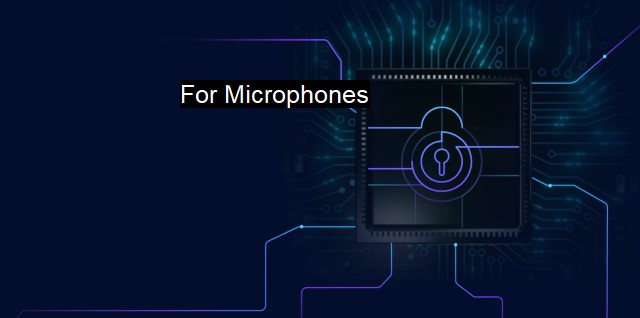What are For Microphones?
For Microphones" Cybersecurity and Antivirus Software: Protecting Against Audio Capturing Malwar
As we delve deeper into the world of cybersecurity, we discover a multitude of devices that require stringent protection against malicious invasions. One such device imperative to many personal and professional operations is the humble but crucial microphone. Just as antivirus software safeguards our data from malicious software such as viruses, trojans, worms, or ransomware, we need specific protections for microphones. Why? Because microphones, in the digital era, can serve as gateways for cyber-attacks.Microphones, along with other connected devices such as webcams, essentially work as an input mechanism for your computer or smartphone. Any hardware that involves input/output operations can pose a cybersecurity threat, given that all a hacker needs is an open channel to infiltrate your system.
Consider this - while using the microphone on your device, you give certain apps or services permission to access it. In the event of a cybersecurity breach, these pathways could become fully open for exploitation by hackers but without you being aware of it. Unprotected microphones could leak sensitive information shared during private calls or meetings. For instance, in corporate environments, conversations discussing classified information over a vulnerable microphone could lead to a serious breach of privacy and information leakage.
This is where a specific set of security measures for microphones comes into play. These steps may include inter alia user-training to understand the potential risks, configuring personalized security settings, using a quality microphone with encryption assurance, network-level protection, and robust antivirus mechanisms aimed at safeguarding microphone interactions.
The fewer privileges you provide to apps, lesser are your chances of being a cyberattack victim, given that there are fewer gates for any potential hacker to enter. many modern-day antimalware solutions contain dedicated modules for webcam and microphone protection. These tools could notify you when an unknown or unwanted program tries to access your microphone, and you may immediately block such attempts. Conversely, you may whitelist certain applications you trust to stop receiving alerts about them.
A feature distinctive to an ideal antivirus is shielding against audio spyware. Audio spyware, or audio surveillance malware, is a class of spyware that exploits microphones to record and transmit audio. Given the higher reliance on remote communication tools amid the pandemic scenario, many such tools with embedded malicious codes could secretly exploit microphone access permissions paving way to spy and record private conversations.
Eavesdropping attacks via microphones have seen a worrisome escalation. Nearby or remote systems infected with a malware named "Mosquito" can interact with a system via ultrasonic transmissions. As microphones can receive such ultrasonic waves, hackers can communicate between devices over air-gapped networks. The relevance of microphone security within the cybersecurity sphere has hence accentuated now more than ever.
Sonic and ultrasonic signals are also an issue. It refers to a range of sound waves frequencies that humans cannot hear. Cybercriminals design malware that is effective at picking up these frequencies from your device's microphone. Such signals could encode and transmit sensitive data from your system. It creates a potential scenario wherein sensitive information could be stealthily siphoned out of ostensibly secure systems without sounding any alert, and reiterating - microphones could serve as the weakest link paving way to this theft.
Microphones in our devices can become covert avenues for cybercriminals to exploit and jeopardize our security. Infusing strong security measures focused on microphones and leveraging robust antivirus solutions remains cardinal to ceasing any such potential exfiltration attempts. Engaging in awareness and robust practices surrounding microphone usage and understanding the extensive role of digitized risks in today's interconnected era are consequently of pivotal essence to combat cyber threats efficaciously. As Edward Snowden rightly said, "Arguing that you don't care about privacy because you have nothing to hide is no different than saying you don't care about freedom of speech because you have nothing to say." Cybersecurity concerns are more intense and advanced than ever before; therefore, every device, including the seemingly innocuous microphone, mandates exhaustive safeguarding measures.

| | A | | | B | | | C | | | D | | | E | | | F | | | G | | | H | | | I | | | J | | | K | | | L | | | M | |
| | N | | | O | | | P | | | Q | | | R | | | S | | | T | | | U | | | V | | | W | | | X | | | Y | | | Z | |
| | 1 | | | 2 | | | 3 | | | 4 | | | 7 | | | 8 | | |||||||